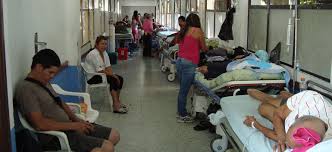
Colombia is a South American country with a population of over 50 million. Its healthcare system has been ranked in the top 30 in the world and the highest ranked in South America. Over half of the best hospitals in South America are located in Colombia, most of which are in the 3 major cities. Life expectancy has risen over the last couple of decades. Some mortality rates have gone down. However, some diseases like AIDS and Hepatitis B have gone up. AIDS is still one of the leading causes of death, especially in women and children. There have been successful vaccination campaigns against tropical diseases like Malaria and Yellow Fever. Around 28% of the population is living in poverty and about 21% of children under 5 suffer from malnutrition.
Colombia’s new constitution in 1993 made healthcare a basic right for all citizens and foreigners. Law 100 of 1993 set up the legal framework of the new Colombian health care system. It also mandates that health insurance be compulsory, that health providers have administrative autonomy and that patients have free choice of healthcare providers. The next few decades saw more change and reforms and Colombia now has universal coverage. Healthcare coverage rose from 21% in 1993 to about 86% in 2006 and is now around 96%. Colombia’s health system is made up of a social security sector and a private sector. The backbone of the system is the General Social Security Health System, which has two plans, contributory and subsidized.
SISBEN is the national system of identification of beneficiaries for social subsidy. It also classifies people that should receive public services. This is a free government-subsidized healthcare system and is only for the very poor or homeless. EPS is the public healthcare system and is mandatory for all residents. The monthly premium is 12.5% of the monthly gross income. EPS plans include dental insurance. To see a specialist, receive diagnostic tests such as blood work, x-rays, or undergo surgery then a referral from a primary care doctor is required. EPS plans cover family members and dependents. Some EPS providers have complementary plans that offers more coverage and priority service to the patient. The Prepagada health insurance is the private insurance of Colombia. With Prepagada you get high-quality healthcare. Plans are very different and can vary in price. It can be very hard to get private insurance if you are over 60 or have a pre-existing condition. Regardless of insurance status, all citizens are eligible to receive the benefits of the public health intervention package.

Colombia’s health system is financed by multiple sources. Some resources are through specific destination taxes and, in other cases, from project taxes and investment funds. In general, healthcare in Colombia is very affordable. About 20% of government spending is directed towards healthcare and approximately 5% of Colombia’s GDP is related to healthcare. This level of investment by the government, has made the costs for patients accessible. Under the EPS, there is a three-tiered payment system. These payments cover co-payments for lab tests, diagnostic imaging, specialist visits, and medications. These rates change in January of each year. The 2019 tiers are $1, $4.25, and $11.15. Some health issues are excluded from co-payments like pregnancy, childbirth and diabetes.
Despite the great strides Colombia has made to its healthcare system, there is still much work to be done. There are significant differences in the standard of care between rural and urban areas. Urban centers have nearly 100% of health coverage while some rural areas would be lucky to have half that. All the best medical facilities are in the cities and can be difficult for rural residents to reach. The standards of care are very limited and clinics may be basic in rural areas. Diseases like AIDS and Malaria are still quite prevalent. Wait times at public facilities can be quite long and can sometimes take a month or two to be seen. However, Colombia has made great progress to its healthcare system since reforms started in the early 90s and they continue to make even more progress.
